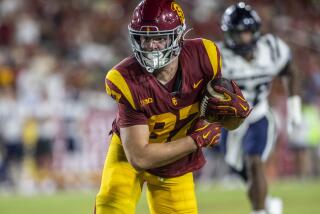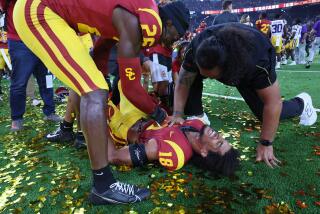A Small Man, a Big Tradition : 25 Years Ago, Mike Garrett Got the Ball Rolling at USC
Twenty-five years ago this month, a compact, iron-willed man from the Maravilla public housing projects in East Los Angeles won the Heisman Trophy.
Mike Garrett established the benchmark for all the USC tailbacks who have followed, from O.J. Simpson to Clarence Davis, Anthony Davis to Ricky Bell, Charles White to Marcus Allen, Ricky Ervins to Mazio Royster.
“He was the one who set the standard, in terms of saying, ‘Give me the ball; I want the ball,’ ” said his coach, John McKay.
Garrett was the first Trojan to average more than 25 carries a game, a practice that later became commonplace, and the first since Morley Drury in 1927 to rush for more than 1,000 yards.
It was Garrett who justified McKay’s faith in the power-I, which has remained USC’s basic offensive formation through three other coaches, but at the time was in its developmental stages.
His influence was such that in 1979--after White joined Garrett and Simpson as Heisman Trophy winners--former assistant coach Dave Levy said: “Without Mike Garrett, we might never have come to the place we are now.”
Simpson, who was raised in San Francisco, has said that it was Garrett’s success that attracted him to USC in 1967.
Although some considered him undersized--UCLA, in fact, stopped recruiting him because it thought him too small--the 5-foot-9, 180-pound Garrett never missed a start in three varsity seasons, rushing for a then-record 3,221 yards, including 1,440 as a senior in 1965.
He was, wrote columnist Jim Murray in The Times, “as elusive as a collar button, as indestructible as a bride’s first set of biscuits.”
His nickname was Iron Mike.
Only White, among the tailbacks that have followed him to USC, averaged more yards a carry than Garrett, who averaged 5.27.
“I still say Simpson was the best player I ever saw, but Garrett was unbelievable,” McKay said. “He had a great ability to just bounce off people and run and run. We were criticized at that time for running him too much, but he never complained.
“He was not a loudmouth. He would not be in fashion today, where everybody slaps hands every time they make two yards. He just did the job.”
McKay first realized Garrett’s ability in the days leading up to the 1963 Rose Bowl game, which matched the unbeaten Trojans against once-beaten Wisconsin for the national championship.
A freshman, Garrett was ineligible to play for the varsity, so he was asked to emulate Wisconsin’s Louis Holland in practice.
USC’s defense had held opponents to 55 points in that ’62 season, but it couldn’t tackle Garrett, who had been hurt most of the season and was only then rounding into shape.
“He was so damn good that we said, ‘If Wisconsin has a better back than him, we’re really in trouble,’ ” McKay said.
As it turned out, few teams had backs as good as Garrett.
With McKay calling his number more frequently each season, he ran for 833 yards as a sophomore and 948 yards as a junior before reaching the 1,000-yard level as a senior, when he scored 16 touchdowns in 10 games.
“We felt that if we were going to win anything, he was the guy we were going to win with because he was not surrounded by other great players, as (the tailbacks) have been since,” McKay said. “He was the first guy who we said, ‘Let him hit every time we get a chance.’
“We ran the ball and ran the ball, and he didn’t seem to mind it. So, being a very astute person, I said, ‘Well, let him have it.’ ”
Garrett, in fact, loved the way the Trojans used him.
“I’m one of those slow learners in the sense that the more I get to do something, the better I get at it,” said Garrett, who lives in Pasadena with his second wife, Suzanne, and two children, Sara, 8, and Daniel, 4. He is the director of boxing and business development at the Forum.
“I always felt comfortable in the fact that I would have X number of chances to carry the ball, and I loved carrying the ball.”
Garrett had been struck by the glamour of the Heisman Trophy when he watched winners Alan Ameche of Wisconsin and Howard (Hopalong) Cassady of Ohio State play on television in the mid-1950s.
The fourth of six children, he was an All-City running back at Roosevelt High, where he ran for 1,467 yards and scored 153 points as a senior, and dreamed of playing for UCLA, which had always been his favorite team.
During the recruiting process, however, UCLA soured on Garrett, and Garrett on the Bruins.
“UCLA, I didn’t feel, was being forthright,” Garrett said. “I didn’t like the feel I got from their people. USC people were more genuine, and the UCLA people were more affected, nouveau riche kind of people.”
Garrett enrolled at USC, where McKay was tinkering with an I-formation attack that would make the tailback as much a focal point of the offense as the quarterback.
It turned out to be a perfect marriage of system and athlete.
“Garrett was the prototype USC tailback,” a Sports Illustrated reporter wrote many years later. “He brought to the new offense the quality a great actor brings to a great part--Olivier playing Othello, Bogart playing Charlie Allnutt.”
In the I formation, the tailback starts from a standing position, several yards straight behind the quarterback, where he is able to see the best running angles and read the blocks of his teammates.
It was perfect for Garrett, whose greatest strengths as a runner were his agility and vision.
The plays were uncomplicated, “but if you stopped the power (blast), I might jump across and run to the opposite side of the field,” Garrett said. “Because of that, our three basic plays became six or seven plays.”
McKay at first called the offense a shifting-T because, although the Trojans usually lined up in an I, they often shifted out of it.
But the more Garrett carried the ball out of the basic I formation, the more McKay was convinced of the attack’s potential.
Said Garrett: “When he realized I had the ability to read the linebackers and the flow of the defense, he said, ‘I’m going to leave this sucker behind the fullback and let’s play it.’ ”
That much settled, McKay shifted his attention to another question: How often could Garrett carry the ball without breaking down?
Garrett said that in the Monday practice after USC’s opener in 1965, a 20-20 tie with Minnesota in which Garrett carried 33 times for 146 yards, McKay wouldn’t stop staring at him.
“It was piercing,” Garrett said.
Finally, McKay approached and asked if he felt abnormally sore.
When Garrett told him that, in fact, he felt great, McKay apparently came to the realization that Garrett could carry the ball as often as was asked of him.
He averaged 30 carries in USC’s first five games, rushing for 852 yards and seven touchdowns to gain national attention.
In 10 games that season, only Notre Dame and California held Garrett to fewer than 100 yards rushing--and in a 35-0 victory over Cal, Garrett returned punts 87 and 74 yards for touchdowns.
He carried 40 times against UCLA, gaining 210 yards in a 20-16 loss that deprived the Trojans of a Rose Bowl bid.
USC was 21-8-1 in three seasons with Garrett but never played in the Rose Bowl. McKay called it one of his greatest disappointments.
Still, “he convinced us (the offense) would work and that it was a great system,” McKay said.
Using the I, USC won national championships in 1967, 1972 and 1974 under McKay, then won another in 1978 under John Robinson.
Garrett signed with the Kansas City Chiefs and played eight seasons in the NFL, the last four with the San Diego Chargers. He ran for 5,481 yards and scored 49 touchdowns as a pro and was the first player to run for more than 1,000 yards with two teams.
He played in Super Bowls II and IV with the Chiefs.
An outfielder and .300 hitter at USC, Garrett announced his retirement from football after the 1970 Super Bowl, saying that he planned to sign with the Dodgers. But the Dodgers, he said, never made him a reasonable offer.
He returned to the NFL, playing until he retired in 1973.
He worked for several years as a counselor for juvenile delinquents and earned a law degree in 1985. In 1982, he ran an unsuccessful write-in campaign for Congress. In 1983, he ran an unsuccessful campaign for the San Diego City Council.
In addition to his duties at the Forum, Garrett also works as a commentator on Prime Ticket’s telecasts of USC football games.
He is best known, however, as the forerunner to Simpson, Davis, Bell, White, Allen, et al.
It was Garrett who put the power in the power-I.
More to Read
Go beyond the scoreboard
Get the latest on L.A.'s teams in the daily Sports Report newsletter.
You may occasionally receive promotional content from the Los Angeles Times.






